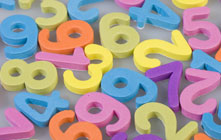Tips to Helping your Fourth Grader with Multiplication Homework
Here are some ways to help your child learn multiplication and make fourth grade math homework fun.

Multiplication can be a difficult concept for kids to master. But, believe it or not, there are many tricks that make multiplying easy to learn and easy to use. You can begin teaching your 4th grader his or her multiplication tables by practicing with these fun tips and soon they will be multiplying any number they see.
Getting Started
First, you should always concentrate on learning one set of multiplication tables at a time. You should begin working on 2's, then move onto 3's, then 4's, and so on. As you work with your child you can begin to build a collection of flashcards. Write down the problems and let your child figure them out. Have them write down answers on the backs of the cards. They can then use these to study with you or by themselves. As they learn one set, you can have them fill out new, blank flashcards to make sure they understand and know the set.
Trick #1
To help your child with multiplication sets that have two as a factor your can remind them that the multiplication facts with 2 in them can be worked just like adding the other number to itself. For example: 2 x 4 is really 4 + 4, they both equal 8. This can help you child to see that multiplication is a lot like addition, just written in a more compact form.
To continue with this idea, the multiplication facts involving 4 are just like adding the other number 4 times. Some call it the 'double and then double again' approach. 4 x 4 is 16 because 4 + 4 = 8 and 8 + 8 = 16.
Trick #2
The number 5 has two tricks. When your child multiplies 5 by an even number all they have to do is halve the even number and put a zero after it. Half of 6 is 3, so 5 x 6 = 30.
For odd numbers subtract 1 from the odd number then divide the answer in half and put a 5 after it. For example: 7 - 1 = 6 and half of 6 is 3, then put a 5 after it to get 35, so 5 x 7 = 35.
Trick #3
There is also a trick for the multiplication facts involving 9. Teach your child the - 1 approach. For example: 2 x 9 = 18 since 2 - 1 is 1, 9 - 1 is 8; put them together and you get 1! Similarly, 3 x 9 = 27 because 3 - 1 is 2, 9 - 2 is 7; put them together to get 27.
Or, you can use the finger approach. Hold up all ten fingers, then put the one you're multiplying by 9 down (if your doing 9 x 6 then put your thumb down on your right hand). The number of fingers that will be left standing on your left hand represent the digit in the tens place(5), the number of fingers left up on your left hand represent the digit in the ones place (4). So, that means the answer to 9 x 6 is 54.
Other Multiplication Tricks
In order to come up the answers for other multiplication problems, you can draw lines on a piece of paper. To find the answer to 5 x 4, have your child draw 5 horizontal lines and then 4 vertical lines intersecting them. There are 20 intersecting points of these lines in all, and 20 is the answer to 5 x 4. Another easy way to visualize multiplication equations is to use little candies or crackers or something similar to represent each part of the equation. This way your child can learn how to multiple quickly by using the addition and subtraction skills they already know.
These are just a few of the many ways to learn how to multiply and you can help your child to find the way that is most easy for them to remember. The most important thing when helping your fourth grader is to show them how easy it is to learn multiplication. Once they find a way they enjoy and understand, they can multiply anything like a pro!
Other Articles You May Be Interested In
-
Sample Math Worksheet - Simple and Advanced Multiplication Tables

This sample worksheet shows you how to structure both basic and advanced multiplication tables. These formats are meant to help students memorize simple multiplcation problems and, when randomized, challenge them.
-
5 Free and Fun Math Games for Kids

Looking for a way to get your child engaged with math? There are many free, fun math games online that explore basic concepts such as addition, subtraction, multiplication and division, as well as more advanced games that offer practice with decimals and fractions. Read on to discover five of our favorite educational - and fun! -...
We Found 7 Tutors You Might Be Interested In
Huntington Learning

- What Huntington Learning offers:
- Online and in-center tutoring
- One on one tutoring
- Every Huntington tutor is certified and trained extensively on the most effective teaching methods
K12

- What K12 offers:
- Online tutoring
- Has a strong and effective partnership with public and private schools
- AdvancED-accredited corporation meeting the highest standards of educational management
Kaplan Kids

- What Kaplan Kids offers:
- Online tutoring
- Customized learning plans
- Real-Time Progress Reports track your child's progress
Kumon

- What Kumon offers:
- In-center tutoring
- Individualized programs for your child
- Helps your child develop the skills and study habits needed to improve their academic performance
Sylvan Learning

- What Sylvan Learning offers:
- Online and in-center tutoring
- Sylvan tutors are certified teachers who provide personalized instruction
- Regular assessment and progress reports
Tutor Doctor

- What Tutor Doctor offers:
- In-Home tutoring
- One on one attention by the tutor
- Develops personlized programs by working with your child's existing homework
TutorVista

- What TutorVista offers:
- Online tutoring
- Student works one-on-one with a professional tutor
- Using the virtual whiteboard workspace to share problems, solutions and explanations